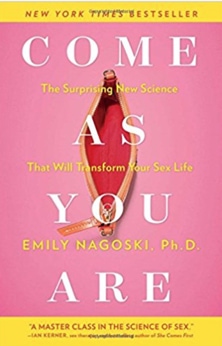
Table of Contents
The surprising science that will transform your sex life.
We all know that we have sexual turn-ons and turn-offs. We might sometimes have trouble identifying what exactly they are in ourselves and others, but we know they’re there. With inspiration from sex educator and TEDx speaker Emily Nagoski, I’m inviting you to apply that turn-on/turn-off concept in a wider and more intentional way in your own relationships. Let’s explore how.
According to Nagoski, there are two brain components that relate to the initiation and conclusion of a satisfying sexual experience: an “accelerator” and a “brake.” This is called the “dual control model” because there are two things in the brain (a “go” and a “stop”) that control our level of sexual desire and arousal.
The accelerator and the brake
The accelerator, as I’ll continue to call this concept, is the part of your brain that actively notices sexually relevant information and moves toward pleasurable stimuli. It functions at a low level all the time, and it’s what inspires you to do a double-take at someone cute in the grocery store or respond positively to a playful spank from your partner.
For the accelerator to kick into high gear, you must be in the right context—the environment has to be pleasurable and safe, low stress, and with a partner with whom you feel affection and trust.
The brake is the part of your brain that notices reasons to not be sexually aroused and avoids those more unpleasant things and sensations. It responds to stress, inhibitions, and threats. The brake in your mind is the reason you don’t “get busy” with a partner in public or when your in-laws are asleep in the next room.
An environment not conducive to pleasure, safety, affection, and trust will cause us to back away from even the most tempting sexual stimulus. Often, this brake is more active than we would like it to be due to cultural ideas about sex as wrong or dirty, causing shyness, reticence, and “stage fright.”
Phil and Becca: A case study
Phil and Becca, married for seven years with one five-year-old daughter, don’t seem to be able to line up their libidos anymore. When Phil is in the mood, Becca isn’t, and vice versa.
Right now, Phil often tries to initiate sex after they’ve had long, hard days together as a family and he wants to reconnect with his partner and have some playful “us” time. When Becca is tired and her back hurts, the last thing she wants to do is be physically intimate. Now that she’s in bed, she’d rather just get some rest.
Becca, on the other hand, feels much friskier on Fridays when the kids are having their weekly visit at their grandparents’ house. Phil doesn’t reciprocate because he knows his buddies will be over soon for Poker night.
To have an enjoyable sexual experience, Becca needs a quiet and kid-free environment – these are the conditions in which she can let go and have some fun. Phil’s accelerators include their daily successes as a couple, and his brakes include feeling rushed.
By learning and discussing their sexual desire accelerating and braking factors, Phil and Becca could arrange some mutually beneficial sexual experiences that won’t leave them feeling disconnected and at odds.
The Dual Control Model in your relationships
You can apply this model to your own sexual experiences for more fulfilling and fun encounters, especially if you’re experiencing sexual problems within your relationships.
Here are some evidence-based guidelines we can extrapolate from Nagoski’s lecture:
- Create a space for desire: When you are in the mood to establish an environment ripe for sexuality, you need to make it as suitable as possible for feelings of trust, affection, relaxation, and peace. If you and your partner haven’t been intimate in a while, don’t try to initiate something sexual on the living room couch when your roommates are due home any minute. Set up a scene with intention.
- Communicate your turn-ons and turn-offs: Learn your own accelerating and braking factors and relay them clearly to your partner. This may take some purposeful experimentation, so keep the conversations flowing!
- Be open to learning about your partner’s sexual desire: Learn what pushes your partner’s sexual buttons, both positively and negatively. This can be achieved at least in part through observation, but you’re definitely going to need to discuss the matter as well. Check-in regularly with your partner, even if you’ve been partners for years.
Nagoski has plenty of other great insight, which she delivers with a great sense of humour, so I highly recommend you watch the entire video below for some more thoughts on developing healthy sexuality—both independently and within relationships!
Also check out Emily’s excellent book called, Come as You Are: The Surprising Science That Will Transform Your Sex Life.
Do you need help with your sexual relationship?
If you need help with your sexual relationship or any other relationship issue, contact Clinton Power + Associates for a FREE 15-minute phone inquiry call to discuss your situation and find out how we can help. Call us now on (02) 8968 9323 or book your free phone consult online.
Since 2003, Clinton Power has helped thousands of couples and individuals as a counsellor and psychotherapist in private practice in Sydney and online in Australia. Clinton regularly comments in the media on issues of relationships and has appeared on Channel 7, The Sydney Morning Herald, and ABC Radio. Clinton’s eBook, 31 Days to Build a Better Relationship is available through his website or Amazon. Click here to take Clinton’s relationship checkup quiz to find out how well you know your partner.

